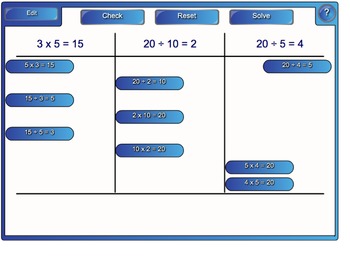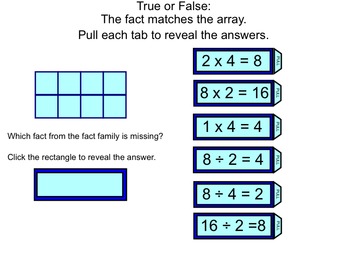Multiplication and Division Fact Families SMARTboard Lesson
Not Your Mother's Math Class
2.9k Followers
Grade Levels
2nd - 5th, Homeschool
Subjects
Resource Type
Standards
CCSS3.OA.A.1
CCSS3.OA.A.2
CCSS3.OA.A.4
CCSS3.OA.B.5
CCSS3.OA.B.6
Formats Included
- NOTEBOOK (SMARTboard) File
Pages
21 pages
Not Your Mother's Math Class
2.9k Followers
Description
Multiplication and Division Fact Families - an interactive SMARTboard lesson
This file contains and explanation of multiplication and division fact families for students and illustrates the concept with arrays.
This file was created for use with a SMARTboard. If you do not have SMART Notebook software, you will not be able to open this file.
Using this presentation will give students opportunities to come to the board to solve problems and display concepts. There is also an independent practice assignment for students to demonstrate what they have learned.
Through the interactive slides, students will:
• use 1 fact to come up with the other 3 facts in the family.
• sort equations into fact families.
• determine the equations that describe an array.
At the end of the presentation there are directions for students to complete an assignment that requires them to cut out 4 arrays and write the equations that describe each array. For this assignment each student will need:
• 1 piece of construction paper
• 1 piece of graph paper (attachment included)
• scissors
• glue
• a pencil
~~~~~~~~~~~~~~~~~~~~~~~~~~~~~~~~~~~~~~~~~~~~~~~~~~
Please download the preview to see the lesson before making a purchase. Some of the interactive features are not visible in the PDF preview. If you have any questions you may ask them by clicking on "Ask a Question" on my store page.
~~~~~~~~~~~~~~~~~~~~~~~~~~~~~~~~~~~~~~~~~~~~~~~~~~
Do you love teaching with the SMARTboard? Click here to see my other SMARTboard lessons.
Click here for more Multiplication and Division Fact Families.
This file contains and explanation of multiplication and division fact families for students and illustrates the concept with arrays.
This file was created for use with a SMARTboard. If you do not have SMART Notebook software, you will not be able to open this file.
Using this presentation will give students opportunities to come to the board to solve problems and display concepts. There is also an independent practice assignment for students to demonstrate what they have learned.
Through the interactive slides, students will:
• use 1 fact to come up with the other 3 facts in the family.
• sort equations into fact families.
• determine the equations that describe an array.
At the end of the presentation there are directions for students to complete an assignment that requires them to cut out 4 arrays and write the equations that describe each array. For this assignment each student will need:
• 1 piece of construction paper
• 1 piece of graph paper (attachment included)
• scissors
• glue
• a pencil
~~~~~~~~~~~~~~~~~~~~~~~~~~~~~~~~~~~~~~~~~~~~~~~~~~
Please download the preview to see the lesson before making a purchase. Some of the interactive features are not visible in the PDF preview. If you have any questions you may ask them by clicking on "Ask a Question" on my store page.
~~~~~~~~~~~~~~~~~~~~~~~~~~~~~~~~~~~~~~~~~~~~~~~~~~
Do you love teaching with the SMARTboard? Click here to see my other SMARTboard lessons.
Click here for more Multiplication and Division Fact Families.
Total Pages
21 pages
Answer Key
N/A
Teaching Duration
50 minutes
Report this resource to TPT
Reported resources will be reviewed by our team. Report this resource to let us know if this resource violates TPT’s content guidelines.
Standards
to see state-specific standards (only available in the US).
CCSS3.OA.A.1
Interpret products of whole numbers, e.g., interpret 5 × 7 as the total number of objects in 5 groups of 7 objects each. For example, describe a context in which a total number of objects can be expressed as 5 × 7.
CCSS3.OA.A.2
Interpret whole-number quotients of whole numbers, e.g., interpret 56 ÷ 8 as the number of objects in each share when 56 objects are partitioned equally into 8 shares, or as a number of shares when 56 objects are partitioned into equal shares of 8 objects each. For example, describe a context in which a number of shares or a number of groups can be expressed as 56 ÷ 8.
CCSS3.OA.A.4
Determine the unknown whole number in a multiplication or division equation relating three whole numbers. For example, determine the unknown number that makes the equation true in each of the equations 8 × ? = 48, 5 = __ ÷ 3, 6 × 6 = ?.
CCSS3.OA.B.5
Apply properties of operations as strategies to multiply and divide. Examples: If 6 × 4 = 24 is known, then 4 × 6 = 24 is also known. (Commutative property of multiplication.) 3 × 5 × 2 can be found by 3 × 5 = 15, then 15 × 2 = 30, or by 5 × 2 = 10, then 3 × 10 = 30. (Associative property of multiplication.) Knowing that 8 × 5 = 40 and 8 × 2 = 16, one can find 8 × 7 as 8 × (5 + 2) = (8 × 5) + (8 × 2) = 40 + 16 = 56. (Distributive property.)
CCSS3.OA.B.6
Understand division as an unknown-factor problem. For example, find 32 ÷ 8 by finding the number that makes 32 when multiplied by 8.





